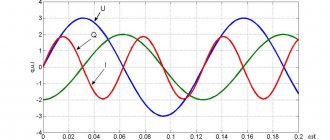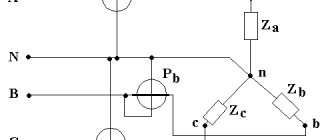What are the dangers of exceeding the permitted power?
Currently, when it detects that the maximum load has been exceeded, the electric company introduces a consumption limitation mode. The basis for this is a violation of the obligations specified in the energy supply agreement. As a rule, limiting consumption is turning off the electric current. The algorithm for sending such a notification is shown in the figure.
Example of a consumer notice
After 10 days after sending the notice, the company disconnects the power supply. To avoid this, the consumer must eliminate the violation within ten days, and then contact the service provider to draw up the appropriate report. Electricity supply will be restored after the electric company pays the penalty in accordance with the contract.
More serious consequences may arise if, in addition to violating the amount of allocated energy, an accusation of uncontrolled electricity consumption is brought forward. The basis for this will be the removal of seals from the input machine. You can get more detailed information about the consequences of uncontrolled electricity consumption, electricity metering rules, etc. on our website.
Seal on the introductory machine (marked in red)
for Legal entities and Individual entrepreneurs:
1. Layout of power receiving devices (ERDs) that need to be connected to the electrical networks of the network organization. The plan contains information about the geographical location of the site on which the EPU are (will be) located. 2. Single-line diagram of the applicant’s electrical networks connected to the electrical networks of the network organization. 3. List and power of energy receiving devices. 4. Documents confirming the ownership or other basis provided by law for a capital construction project and (or) the land plot on which (in which) the applicant’s objects are located (will be located), or the right of ownership or other basis provided by law for energy receiving devices (provided in one copy in the form of a simple copy), for example: a certificate of state registration of rights (property, etc.), a valid lease agreement (with a mark of state registration for a lease period of more than 1 year). In the case of shared participation in the rights to an object, land plot or energy receiving devices, written consent is provided from the remaining owners or a person authorized by them to draw up documents on technological connection in the name of the applicant and to carry out the necessary technical measures in relation to the common property. 5. Power of attorney or other documents confirming the authority of the applicant’s representative submitting and (or) receiving documents. For an authorized person of the organization: - a simple written form of power of attorney signed by the head of the organization, certified by the seal of the organization. When submitting an application, it is recommended to have the original power of attorney.
For the heads of the organization: - minutes of the general meeting of shareholders/participants (or the decision of the sole participant/shareholder) on the appointment of the head of the organization. A notarized copy or a copy certified by the seal and signature of the head of the organization is accepted. At the request of the applicant, a simple copy may be submitted in addition to this.
Design power for industrial facilities
The design capacity of an industrial enterprise depends on:
- type of product;
- technologies used;
- expected maximum load during the year;
- type of products;
- type of equipment and the degree of its adaptation to technology.
There are many calculation methods, all of them must have common properties:
- ease of calculation;
- versatility in determining loads for different levels of energy consumption and distribution;
- accuracy of results;
- ease of determining the indicators on which the method is based.
The main indicators are calculated using the same formulas, but with different correction factors.
For three-phase electric motors, the installed power is:
Р = Рн/(η x cos φ), where:
- Рн – nominal power indicator from the data sheet;
- η – efficiency of the electric motor;
- cos φ – power coefficient.
An increase in the allocated power, according to technical conditions, must be agreed upon with the energy supply organization. For this purpose, recalculations are carried out for input cables and protection devices based on the new installed power. But the decision to allocate depends on the availability of free capacity.
Factors affecting the size of production capacity
Production capacity parameters are determined by the following factors:
- The perfection of the technologies used.
- The range of goods and its quality.
- The quality of work organization.
Sometimes the results of PM calculations in different periods differ significantly. This is a result of the instability of the factors given above. For example, the company is constantly introducing new equipment. Production technology and tools used are the main factors influencing power parameters.
What it is
During capital construction during the USSR, for example in Khrushchev buildings, i.e. In most of the residential premises that are still in use today, even at the design stage, the allocated power was 1.5 kW per apartment. Later, the established electricity rate increased to 3 kW, as it became necessary to increase it due to the increased “gluttony” of consumers. Practice shows that 10-16 Ampere plugs were usually installed in electrical panels and meters, so that the maximum current consumed by an apartment was limited to a total electrical power of 3 kW for apartments with a gas stove. For apartments where an electric stove is installed, 7 kW is allocated. In new buildings, the allocated power can reach up to 15 kW. This scatter is due to the fact that during the construction of old houses (60s, 70s) there simply were not such powerful consumers and as many household appliances as there are now.
The allocated power is the maximum amount of electricity consumed at one point in time.
In addition, in order to enter the established limit, sometimes you need to enter not just 1 phase, as often happens, but as many as 3 phases. This is necessary for connecting modern household appliances, such as powerful electric boilers and electric stoves. This is especially true in commercial premises and industries of any scale, where a lot of electricity is needed (up to 30 kW and above).
Example
. To heat a country house that is not equipped with gas equipment, solid fuel and electric boilers are installed, the latter are safer and more convenient. For heating a house with an area of 100 sq.m. you need a boiler with a power of about 7-10 kW, an electric stove consumes another 3-5 kW. In total, it is necessary to increase the established electricity limit to a minimum of 15 kW and supply electricity in three phases.
To find out the allocated power for a private house or apartment, you need to contact the operating organization (in Moscow and the region - this is Mosenergosbyt OJSC). The help contains information about the allocated and average power consumption. It will be needed if you are preparing documents for an increase; this will be discussed in detail below.
The concept of permissible electrical power for an apartment and ways to increase it
Based on para. 7 clause 2 of Rule No. 861, the maximum installed electrical power is the largest amount of power that can be allocated by the electricity provider. It is measured in kilowatts, taken into account by common house and apartment appliances, and paid according to the established tariff. But in some cases, the power is not enough, and consumers begin to think about increasing it through legal means.
- What is “dedicated power” of electricity?
- What are the dangers of exceeding the permitted power?
- Rules and regulations
- How to find out how much power is allocated
- Calculation of required power
- How many kilowatts can the wiring in the apartment withstand?
- How to increase allocated power
- For individuals
- For legal entities and companies
Estimated power of residential buildings
The installed power in a residential building is determined based on the sum of the consumer rated powers of all electrical appliances and installations, and the calculated power - taking into account the expected simultaneous switching factor.
Each subscriber has a delineation act, which records the installed and calculated power. These values are different for houses and apartments. Houses and some apartments are usually supplied with three phases, which allows increasing the consumption (calculated) indicator. Single-phase input significantly limits consumption. The load is controlled by protective equipment designed to handle the maximum possible currents.
- If there is no power plant in the house or apartment, the calculated energy is determined by the formula:
P1 = Pmax + M x Rchel, where:
- Pmax is the power of the largest receiver installed in the apartment,
- M – number of inhabitants,
- Rchel – estimated power per person (for example, 1 kW);
Important! This formula does not take into account heating of residential premises
- The estimated power of the power supply cable for an apartment building is made taking into account the number of apartments:
Р = Р1 x nxk + Ra + Рл, where:
- n – number of apartments,
- k – simultaneity coefficient (it ranges from 0.6 to 0.8),
- Ra – installed power of administrative electrical receivers,
- RL – elevators.
If there is no data, then Pa is taken equal to 0.5 kW, Rl = 20 kW.
- With electric heating, Po = P + K1 x ΣRkv, where:
- P – design power without electric heating,
- K1 – coefficient of simultaneity of heat load in n apartments,
- Rkv – heating energy in one apartment, kW.
Important! Accurate determination of the estimated power required for space heating requires detailed calculations, which are carried out jointly with builders and building designers. In residential buildings with predominant heating elements cos φ = 1
- The calculated power indicator for a group of buildings is determined by the empirical formula:
Рз = 0.95 x kx ΣР, where Р is energy for one building.
Basic calculation rules
When determining production capacity, the following rules must be taken into account:
- When taking into account available equipment, each form of equipment must be taken into account. It is impossible to exclude from accounting non-working equipment, tools that are being repaired or are idle. Only reserve equipment, which serves as a replacement for used resources, is not taken into account.
- If new equipment is put into operation, when recording it, it is necessary to take into account the time of start of use.
- The maximum possible operating capacity of the equipment must be taken into account. In this case, the adopted shift mode is taken into account.
- You need to focus on comparable values of equipment operation and power balance.
- When calculating, values are used based on the full load of resources.
- When determining PM, equipment downtime is not taken into account, regardless of its reasons.
The manager is obliged to provide reserves for PM. This is necessary to be able to quickly respond to increased demand. For example, an enterprise operates at a certain PM. However, the demand for garden carts produced by the entity is increasing sharply. To meet all consumer needs, it is necessary to increase production capacity. This is why reserves are required.
Production capacity calculation
The calculation is carried out on the basis of passport and design standards. If the company's employees consistently exceed established labor productivity standards, the increased indicator is taken into account. Consider the calculation formula:
M = Tef * N
Where
- M - production capacity,
- N is the rated productivity of the equipment per unit of time,
- Tef is the planned fund of her work.
To determine Tef, you need to subtract from the calendar fund (365 days) weekends, holidays, intervals between shifts, downtime and other time during which the equipment was not in use.
IMPORTANT! The parameters needed for calculations are determined for each workshop or section.
Calculation of required power
This calculation will be needed to understand whether the amount of allocated electrical power for an apartment or house will be sufficient. To do this, you will need to calculate the maximum load by summing up the corresponding parameters of all consumer electrical installations. Moreover, it is necessary to take into account all household electrical appliances that can be turned on at the same time.
As a rule, all the necessary information is indicated on a sticker affixed to the equipment body or is given in the documentation. If the sticker has become unreadable and the technical data sheet has been lost, you can use the table that shows the typical active power of household equipment.
Table of approximate power consumption of various household appliances
Having calculated the total consumption, do not rush to consider the work completed; it is necessary to add a reserve, taking into account a possible increase in load over time. As a rule, the size of the reserve is set at 20-30% of the calculated parameters.
By adding these two values, we get a result that can be compared with the allowed power. If it turns out to be less than the calculated load, it makes sense to think about applying for an additional 1 kW or 3 kW. Details about adding additional kilowatts will be discussed below.
How many kilowatts are allocated for an apartment?
You bought an apartment and don’t know how much power is allocated . We decided to increase the comfort in an old apartment, make repairs and add more consumers (warm floors, air conditioners, dryer, oven, etc.), but only 5 kilowatts were allocated in the apartment, how to get more power?
If there is enough power, then you can use the required number of electrical appliances without fear of problems, failures, or the machine being knocked out.
Calculation of maximum input power
Electrical load is understood as the amount of electric current flowing in the network when an electrical receiver or group of electrical receivers is turned on.
Based on electrical loads, conductors are selected (design, cross-section) at all stages of generation, conversion, transmission and consumer use of electrical energy and its distribution. There are 3 methods for determining the electrical loads of objects:
1 Method for constructing a daily graph of electrical loads;
2 Method of ordered diagrams or method of effective number of electrical receivers;
3 Analytical method
To calculate the load at the entrance to the dairy block building, the method of constructing a daily graph of electrical loads is used. Since it is possible to install a clear time cycle of technological equipment at the facility.
To construct a load graph, auxiliary table No. 7 is compiled.
Table No. 7. - Auxiliary table for constructing a load graph.
| Technological operation | power, kWt | Operation duration | |||||||||||||||||||||
| 1 | 2 | 3 | 4 | 5 | 6 | 7 | 8 | 9 | 10 | 11 | 12 | 13 | 14 | 15 | 16 | 17 | 18 | 19 | 20 | 21 | 22 | 23 | 24 |
| 1 Milk pump | 2,2 | ||||||||||||||||||||||
| 2 Vacuum - pump | 8 | ||||||||||||||||||||||
| 3 Cooler | 18,74 | ||||||||||||||||||||||
| 4 Separator | 2,2 | ||||||||||||||||||||||
| 5 Heater | 12 | ||||||||||||||||||||||
| 6 Lighting | 1,74 |
A daily load schedule is drawn up (Figure 1).
Figure 1 - Graph of electrical loads.
The graph shows that the maximum active power is:
The installed power is determined by summing up all the loads present at the facility:
, (32)
where is the power of the i-th load, kW.
Electricity consumption per day is determined through the geometric area of the graph:
(33)
Average power consumption per day:
(34)
The average value of the power factor of the loads involved in the formation of the maximum load:
(35)
The total power at the input is determined:
(36)
Input current at maximum load:
(37)
Based on the operating current, we determine the cross-section of the input cable based on the conditions.
Iadd? Iр, (38)
Iadd = 65A? Iр = 52.65A.
We accept for installation a cable at the AVBBShv 5*25 input.
Document overview
The Procedure for forming a consolidated forecast balance of production and supply of electricity (capacity) within the Unified Energy System of Russia by region has been re-approved.
The objectives of creating a balance are to satisfy the demand for electricity and power, minimize the costs of their production and supply, ensure reliable energy supply, as well as balance the total cost of electricity and power supplied to the wholesale market at regulated prices (tariffs) and sold under regulated sales contracts (supplies) in price and non-price zones.
Balance is needed to achieve 3 goals. The first is the calculation of regulated prices (tariffs) for electricity and power, subject to state regulation, as well as regulated prices (tariffs) for services provided in the wholesale and retail markets. The second is the conclusion by participants of the wholesale market of agreements, on the basis of which the purchase and sale of electricity and (or) capacity is carried out on such a market. The third is the conclusion by producers (suppliers) of purchase and sale (supply) agreements for electricity and capacity with a supplier of last resort in regions united in non-price zones. We are talking about manufacturers (suppliers) who are subject to the legal requirement to sell produced electricity (power) only on the wholesale market and who, before receiving the status of a wholesale market entity, participate in purchase and sale relations on the retail market.
The Procedure for determining the ratio of the total annual forecast volume of electricity consumption by the population and equivalent categories of consumers to the volume of electricity corresponding to the annual average value of the forecast capacity determined in relation to these categories of consumers was also approved.
The ratio is established to determine the planned volumes of consumption by the population for the next regulated period based on the results of control measurements. They are carried out by guaranteeing suppliers, energy supply and sales organizations that supply electricity (power) to the population and equivalent categories of consumers in the year preceding the next regulated period.
The order approving the previous procedure for the formation of a consolidated forecast balance was declared invalid.
To view the current text of the document and obtain complete information about the entry into force, changes and procedure for applying the document, use the search in the Internet version of the GARANT system:
What is dedicated electrical power
If we explain the meaning of this term in simple language, then the allocated (or permitted) power is the maximum permissible load on the consumer’s network. It is established in accordance with current standards and is indicated in the electricity supply contract.
Those who want to understand this issue in detail should have an idea of connected, installed, one-time and permitted capacity. Let's give a brief definition of each of them:
- Connected, this term means the total installed power of all electrical receivers powered from the consumer's network.
- Installed - rated active power specified in the technical documentation for electrical equipment, that is, that at which consumer devices will operate in normal mode.
- One-time – the estimated amount of power consumption of electrical installation equipment for a certain time.
- Allocated (allowed) – the maximum one-time power that a consumer can connect to the energy supply company’s network. This parameter is indicated in the specifications for connecting energy-receiving facilities and in the agreement between the consumer and the organization supplying electricity.
Rules and regulations
Electrification of any facility is carried out in accordance with the specifications developed by the company providing electricity supply services. One of the paragraphs of this document indicates the parameters of allocated power for the consumer network. The energy supply company forms technical specifications based on the declared capacity, justified by calculations.
When electrifying residential and public buildings, they are guided by SP 31 110 2003 and temporary instructions PM 2696 01. According to these documents, residential buildings belonging to the 1st category are not standardized in terms of power allocation. That is, if there is a technical possibility, then the technical specifications for connecting such facilities are formed on the basis of the submitted application.
For residential buildings of the 2nd category, two electrification standards are provided:
- 5 - 7 kW, for a private house or apartment, with gas stoves.
- 8 – 11 kW – with electric stoves.
At the same time, the lower threshold for power allocation is provided for small-sized apartments in houses built under the social housing program. Note that these standards were established relatively recently; for electrical installations of residential buildings built before 2006, they were lower.
Installed capacity for power plants
For power plants, the installed power is calculated by summing the power ratings of the individual generators and their associated motors. Almost always these values are identical. In cases of discrepancy, the calculation is carried out using a lower power.
As a result, at expensive stations with high fuel economy, the cost of electricity is extremely dependent on the consumption mode. Therefore, for large stations it is beneficial to use the installed capacity for a maximum of hours per year, and for small gas turbine plants with high fuel consumption, it is more expedient to switch them on during peak load hours, when the total operating time on an annual basis is small.
How to find out how much power is allocated
Those who do not know the amount of permitted power for a house or apartment can use the following ways to obtain information:
- Get a certificate from the energy supply company. It should be taken into account that such a service is considered paid; for example, at Mosenergosbyt you will have to pay from 1.3 to 3.1 thousand rubles for it, depending on the category of the residential property.
- Look for the required parameter in the energy supply contract or technical specifications.
- Obtain information empirically by looking at the parameters of the input protective device. The fact is that in most cases, in addition to its direct functions, it plays the role of a power limiter. To set its maximum value, it is enough to find out the operating current of the machine.
The figure shows a diffautomatic machine with an operating current of 32 A (Inom). Therefore, the maximum permissible load power can be calculated using the formula: Pmax = U x Inom x 0.8; where U is the rated network voltage. Therefore, 230 x 32 x 0.8 ≈ 5.5 kW.
Of all the options presented, the most reliable is the first, especially since a certificate will still be needed if you plan to increase the allocated power (it is included in the package of necessary documents).
Calculations based on the operating current of the input circuit breaker should not be trusted too much. Some models of modern electronic meters have a built-in load relay. In such cases, the rated current of the machine may be overestimated.
How many kilowatts can the wiring in the apartment withstand?
Cable power table depending on cross-section
Under ideal conditions, a standard copper conductor with a cross-section of 2.5 mm2 can withstand a load of 5.9 kW, and an aluminum conductor - 4.4 kW.
Under operating conditions, aluminum conductors of old houses with a cross-section of 2.5 mm2 can withstand 3.5 kW at a current of 16 A. APPVs of 6 mm2 do not burn out at a load of 5.5 kW and a current of 25 A. Wires with a cross-section of 4 mm2 will withstand 4, 4 kW at current 25 A.
According to the rules of the PUE, a three-core copper wire with a cross-section of 1.5 mm2 must withstand a maximum permissible load of 5.9 kW. 4 mm2 cable – 8.3 kW with a current of 28 A. Conductor with a cross-section of 6 mm2 with a current of 46 A – 10.1 kW.
Clock for calculating the actual power value in the retail market
How to measure power consumption and check the meter How to measure power consumption and check the meter Knowing the power is required in many cases. For example: To calculate the required cross-sections of the electrical wiring cable. To determine electricity consumption, power consumption. Let's take a closer look at power consumption. Nowadays there are a lot of household appliances. The approximate operating time in hours and monthly electricity consumption are indicated. Of course, the data is averaged, you can create a similar table for your equipment. Calculate using new data. How can you measure power at home? The most common method is using an electricity meter.
Conditions for transferring maximum power from the energy source to the receiver
Overhead Line > AC Circuits. Theory.
Conditions for transferring maximum power from an energy source to a receiver Let's imagine an energy source with EMF E and internal resistance by an equivalent circuit (Fig. 3.22). Let's find out what the resistance Z=r + jx of the receiver should be so that the active power transmitted to it is maximum. Receiver power Obviously, for any r, the power reaches its greatest value at . In this case, taking the derivative with respect to r from the resulting expression and equating it to zero, we find that P has the greatest value at . Thus, the receiver receives the greatest active power from the source if its complex resistance is conjugate with the complex internal resistance of the source: Under this condition and efficiency In electric power plants, the maximum power transmission mode is unprofitable due to significant energy losses. In various types of automation, electronics and communications devices, the signal powers are very low, so it is often necessary to specially create conditions for transmitting the maximum possible power to the receiver. A decrease in efficiency often does not matter at all, since the transmitted energy is small. Matching the resistances of the receiver and the power source in accordance with (3.50) can also be achieved by adding elements with reactance to the circuit (see example 4.6). Sometimes the resistance of the receiver can be changed without arbitrarily, but only with maintaining the relationship between active and reactance, i.e. at . An analysis, which is not given here, shows that in this case the power P is maximum if the impedances of the receiver and the source () are equal to each other, while matching the impedances of the receiver and the power source can be achieved by turning on the receiver through a transformer. In the general case of a receiver - a branched passive circuit - Z is its input impedance.
See also the section on websor
- Alternating currents
- Concept of alternators
- Sinusoidal current
- Effective current, emf and voltage
- Representation of sinusoidal functions of time by vectors and complex numbers
- Addition of sinusoidal time functions
- Electrical circuit and its diagram
- Current and voltage when connecting resistive, inductive and capacitive elements in series
- Resistance
- Voltage and current phase difference
- Voltage and currents when connecting resistive, inductive and capacitive elements in parallel
- Conductivity
- Passive two-terminal network
- Power
- Powers of resistive, inductive and capacitive elements
- Power balance
- Power signs and direction of energy transfer
- Determining the parameters of a passive two-terminal network using an ammeter, voltmeter and wattmeter
- Conditions for transferring maximum power from the energy source to the receiver
- Understanding the Surface Effect and the Proximity Effect
- Parameters and equivalent circuits of capacitors
- Parameters and equivalent circuits of inductors and resistors










